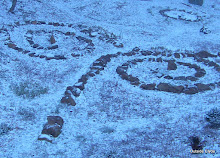Keep your eye on the wall of green just below the Great Lawn if you can. It has something to say about carving a wild cultivated garden out of the wilderness.
A great many of the plants that make up the floral chaos that is the current state of the garden can easily be seen while driving the scenic byway in the pastures, fence rows and forest edges. Native or naturalized, these wild flowers are part of the scenery.
They are nature's plant palette stretched over many miles and across entire regions. When they bloom in abundance they are a sight to behold.
You won't see anything quite like this Tall Flower Meadow while driving the scenic byways though. The plants are all wild, weeds that are free to roam, but nature doesn't work quite like this. What happened here is that a gardener stepped in and started to manipulate what nature had to offer.
I call it editing. What that means in layman's terms is a whole lot of weeding for the most part. I did not plant most of what you see, so much as I removed what I didn't want. Nature followed right behind me filling in all the blank spots. This is the result.
Here is a closer look at the wall of green just below the Great Lawn looking over the lowest and newest section of the Tall Flower Meadow. The section in the foreground is being manipulated by the gardener. The wall of green is by nature alone.
Not so long ago the entire bowl that is now the tall flower meadow was a solid and impenetrable wall of green. Then a gardener arrived and had other ideas.
The difference between nature and the gardener might best be viewed from a sense of scale. Nature has every living organism and the entire planet to work with. The gardener has just a small plot of land and wants a lot of variety to last through the seasons in his personal domain.
Nature is fine with putting just a few dominant species in a meadow because just down the road and around the bend something else will be planted. New England Aster and native impatiens are blooming in there now.
That isn't enough for the gardener who sees such a big space that could be so much more. So I edit. I add, do a whole lot of subtracting and get informed on what to keep and what to pull.
When given a chance by removing the more aggressive, nature freely provides a wealth of alternatives.
One alternative can quickly become many when the editing continues.
And when the gardener does not know what some offering is, he waits. I do believe I now have another shade tolerant species of Goldenrod. I did not plant it. I just did not pull it because I didn't know what it was.
That impenetrable green wall of a meadow below the Great Lawn is my control sample. That is what was. The gardener is definitely making an impact.
Friday, September 12, 2014
Subscribe to:
Post Comments (Atom)

















6 comments:
The really interesting part will be to look at the difference between what we see here and what we see next year.
Nature has a way of moving plants from place to place here. An Agalinis patch from two years ago moves eastward and the whole picture changes. A drought makes a marked difference, as does copious rains.
Nature has her way. Things move here also.
No doubt about it. It is different every year from things growing, moving, dying, self seeding, wet or dry, hot or cool. This year the bloom seems more bunched up. In other years it is more spread out over the weeks.
When I squint my eyes, it looks like an Impressionistic painting!
"Beauty by Editing" - a new gardening book, perhaps?
Yes, Rebecca. Chris needs to think about a book. My year/years on the mountain - something like that.
We can title it "20 years on the Mountaintop". That means I don't have to start writing it for another decade.
Post a Comment